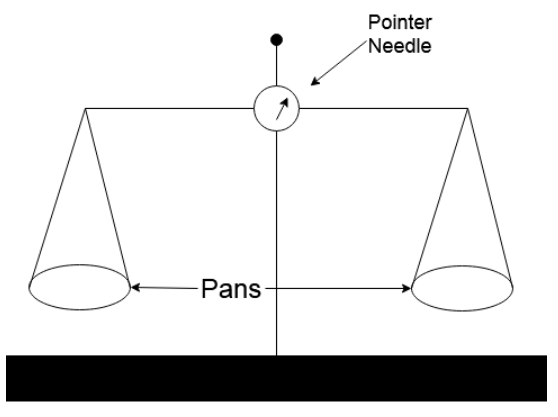
The common balance works on the principle of equality of
(A). Forces
(B). Moment of forces
(C). Masses
(D). Masses of pans
Answer
587.1k+ views
Hint: You can start by describing the basic structure of a common balance. Then explain how we measure the weight of the commodity by keeping the weight in both the pans of the common balance should be equal, if the weight are equal the moment of forces on both the pans are equal.
Complete step-by-step answer:
A common balance is essentially a rod that is fixed on a base as you can in the figure below.

The rod is free to rotate with the base acting as an axis of rotation. At the point where the rod is connected to the base, a pointer needle is also fixed which indicates the degree of rotation in either direction. The two ends of the rod are connected to two pans with the help of strings.
The common balance works on the principle of equality of moment of forces.
The measure of the tendency of a body to rotate about an axis is called the moment of force.
The weight of objects to be compared is kept in the two pans. In normal use, one pan contains the commodity that we want to buy (vegetable, sugar, etc.) and the other pan contains a standard weight. The standard weight represents the amount of the commodity that we want to buy. If the weight of our commodity is equal to the weight of the standard weight and the pointer needle then point to zero. If the pointer needle is not at zero, then it is pointing towards the pan which has more weight in it, and then we have to adjust the weight of objects accordingly. Here more weight in the pan means more moment of force in the direction of the pan.
Hence, option B is the correct option.
Note: A point of consumer awareness is that we should always remain careful when purchasing items measured by the common balance, as sometimes the seller may commit fraud by adding extra weight to the pan where the commodities are placed by attaching heavy magnets or by other means.
Complete step-by-step answer:
A common balance is essentially a rod that is fixed on a base as you can in the figure below.

The rod is free to rotate with the base acting as an axis of rotation. At the point where the rod is connected to the base, a pointer needle is also fixed which indicates the degree of rotation in either direction. The two ends of the rod are connected to two pans with the help of strings.
The common balance works on the principle of equality of moment of forces.
The measure of the tendency of a body to rotate about an axis is called the moment of force.
The weight of objects to be compared is kept in the two pans. In normal use, one pan contains the commodity that we want to buy (vegetable, sugar, etc.) and the other pan contains a standard weight. The standard weight represents the amount of the commodity that we want to buy. If the weight of our commodity is equal to the weight of the standard weight and the pointer needle then point to zero. If the pointer needle is not at zero, then it is pointing towards the pan which has more weight in it, and then we have to adjust the weight of objects accordingly. Here more weight in the pan means more moment of force in the direction of the pan.
Hence, option B is the correct option.
Note: A point of consumer awareness is that we should always remain careful when purchasing items measured by the common balance, as sometimes the seller may commit fraud by adding extra weight to the pan where the commodities are placed by attaching heavy magnets or by other means.
Recently Updated Pages
Compare and contrast a weekly market and a shopping class 10 social science CBSE

By how much is 2500 greater than 500 class 8 maths CBSE

The percentage of the world population of countries class 9 maths CBSE

A floor is 5m long and 4m wide A square carpet of sides class 8 maths CBSE

Which type of mirror has negative focal length A Convex class 10 physics CBSE

The diameter of the circle is 8cm Calculate the radius class 9 maths CBSE

Trending doubts
One Metric ton is equal to kg A 10000 B 1000 C 100 class 11 physics CBSE

Discuss the various forms of bacteria class 11 biology CBSE

Explain zero factorial class 11 maths CBSE

State the laws of reflection of light

Difference Between Prokaryotic Cells and Eukaryotic Cells

Show that total energy of a freely falling body remains class 11 physics CBSE




